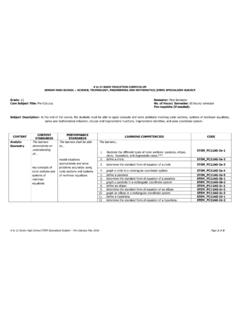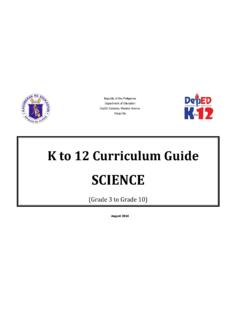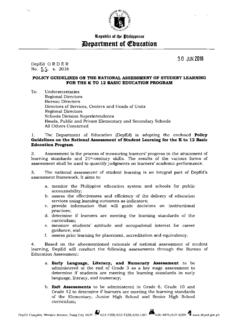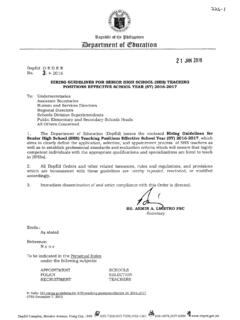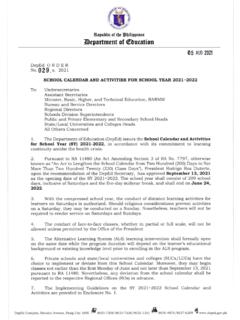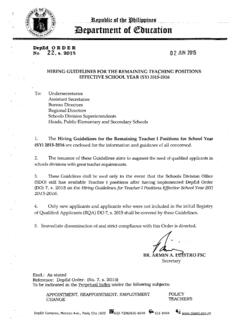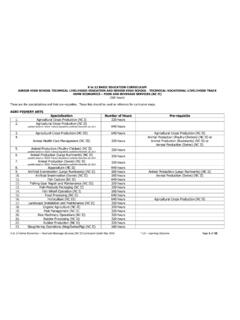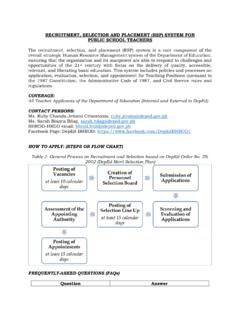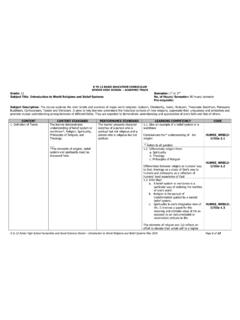Transcription of K to 12 BASIC EDUCATION CURRICULUM SENIOR HIGH …
1 K to 12 BASIC EDUCATION CURRICULUM SENIOR HIGH SCHOOL SCIENCE, technology , engineering AND mathematics ( stem ) specialized SUBJECT K to 12 SENIOR High School stem specialized Subject General Physics 1 May 2016 Page 1 of 13 Grade: 12 Quarters: General Physics 1 (Q1&Q2) Subject Title: General Physics 1 No. of Hours/ Quarters: 40 hours/ quarter Prerequisite (if needed): BASIC Calculus Subject Description: Mechanics of particles, rigid bodies, and fluids; waves; and heat and thermodynamics using the methods and concepts of algebra, geometry, trigonometry, graphical analysis, and BASIC calculus CONTENT CONTENT STANDARD PERFORMANCE STANDARD LEARNING COMPETENCIES CODE 1. Units 2. Physical Quantities 3. Measurement 4. Graphical Presentation 5. Linear Fitting of Data The learners demonstrate an understanding 1.
2 The effect of instruments on measurements 2. Uncertainties and deviations in measurement 3. Sources and types of error 4. Accuracy versus precision 5. Uncertainty of derived quantities 6. Error bars 7. Graphical analysis: linear fitting and transformation of functional dependence to linear form The learners are able Solve, using experimental and theoretical approaches, multiconcept, rich-context problems involving measurement, vectors, motions in 1D, 2D, and 3D, Newton s Laws, work, energy, center of mass, momentum, impulse, and collisions The 1. Solve measurement problems involving conversion of units, expression of measurements in scientific notation STEM_GP12EU-Ia-1 2. Differentiate accuracy from precision STEM_GP12EU-Ia-2 3. Differentiate random errors from systematic errors STEM_GP12EU-Ia-3 4.
3 Use the least count concept to estimate errors associated with single measurements STEM_GP12EU-Ia-4 5. Estimate errors from multiple measurements of a physical quantity using variance STEM_GP12EU-Ia-5 6. Estimate the uncertainty of a derived quantity from the estimated values and uncertainties of directly measured quantities STEM_GP12EU-Ia-6 7. Estimate intercepts and slopes and and their uncertainties in experimental data with linear dependence using the eyeball method and/or linear regression formulae STEM_GP12EU-Ia-7 Vectors 1. Vectors and vector addition 2. Components of vectors 3. Unit vectors 1. Differentiate vector and scalar quantities STEM_GP12V-Ia-8 2. Perform addition of vectors STEM_GP12V-Ia-9 3. Rewrite a vector in component form STEM_GP12V-Ia-10 4. Calculate directions and magnitudes of vectors STEM_GP12V-Ia-11 Kinematics: Motion Along a Straight Line 1.
4 Position, time, distance, displacement, speed, average velocity, 1. Convert a verbal description of a physical situation involving uniform acceleration in one dimension into a mathematical description STEM_GP12 Kin-Ib-12 K to 12 BASIC EDUCATION CURRICULUM SENIOR HIGH SCHOOL SCIENCE, technology , engineering AND mathematics ( stem ) specialized SUBJECT K to 12 SENIOR High School stem specialized Subject General Physics 1 May 2016 Page 2 of 13 CONTENT CONTENT STANDARD PERFORMANCE STANDARD LEARNING COMPETENCIES CODE instantaneous velocity 2. Average acceleration, and instantaneous acceleration 3. Uniformly accelerated linear motion 4. Free-fall motion 5. 1D Uniform Acceleration Problems 2. Recognize whether or not a physical situation involves constant velocity or constant acceleration STEM_GP12 KIN-Ib-13 3.
5 Interpret displacement and velocity, respectively, as areas under velocity vs. time and acceleration vs. time curves STEM_GP12 KIN-Ib-14 4. Interpret velocity and acceleration, respectively, as slopes of position vs. time and velocity vs. time curves STEM_GP12 KIN-Ib-15 5. Construct velocity vs. time and acceleration vs. time graphs, respectively, corresponding to a given position vs. time-graph and velocity vs. time graph and vice versa STEM_GP12 KIN-Ib-16 6. Solve for unknown quantities in equations involving one-dimensional uniformly accelerated motion STEM_GP12 KIN-Ib-17 7. Use the fact that the magnitude of acceleration due to gravity on the Earth s surface is nearly constant and approximately m/s2 in free-fall problems STEM_GP12 KIN-Ib-18 8. Solve problems involving one-dimensional motion with constant acceleration in contexts such as, but not limited to, the tail-gating phenomenon , pursuit, rocket launch, and free-fall problems STEM_GP12 KIN-Ib-19 Kinematics: Motion in 2- Dimensions and 3-Dimensions Relative motion 1.
6 Position, distance, displacement, speed, average velocity, instantaneous velocity, average acceleration, and instantaneous acceleration in 2- and 3- dimensions 2. Projectile motion 1. Describe motion using the concept of relative velocities in 1D and 2D STEM_GP12 KIN-Ic-20 2. Extend the definition of position, velocity, and acceleration to 2D and 3D using vector representation STEM_GP12 KIN-Ic-21 3. Deduce the consequences of the independence of vertical and horizontal components of projectile motion STEM_GP12 KIN-Ic-22 4. Calculate range, time of flight, and maximum heights of projectiles STEM_GP12 KIN-Ic-23 K to 12 BASIC EDUCATION CURRICULUM SENIOR HIGH SCHOOL SCIENCE, technology , engineering AND mathematics ( stem ) specialized SUBJECT K to 12 SENIOR High School stem specialized Subject General Physics 1 May 2016 Page 3 of 13 CONTENT CONTENT STANDARD PERFORMANCE STANDARD LEARNING COMPETENCIES CODE 3.
7 Circular motion 4. Relative motion 5. Differentiate uniform and non-uniform circular motion STEM_GP12 KIN-Ic-24 6. Infer quantities associated with circular motion such as tangential velocity, centripetal acceleration, tangential acceleration, radius of curvature STEM_GP12 KIN-Ic-25 7. Solve problems involving two dimensional motion in contexts such as, but not limited to ledge jumping, movie stunts, basketball, safe locations during firework displays, and Ferris wheels STEM_GP12 KIN-Ic-26 8. Plan and execute an experiment involving projectile motion: Identifying error sources, minimizing their influence, and estimating the influence of the identified error sources on final results STEM_GP12 KIN-Id-27 Newton s Laws of Motion and Applications 1. Newton s Law s of Motion 2. Inertial Reference Frames 3. Action at a distance forces 4.
8 Mass and Weight 5. Types of contact forces: tension, normal force, kinetic and static friction, fluid resistance 6. Action-Reaction Pairs 7. Free-Body Diagrams 8. Applications of Newton s Laws to single-body and multibody dynamics 9. Fluid resistance 10. Experiment on forces 11. Problem solving using 1. Define inertial frames of reference STEM_GP12N-Id-28 2. Differentiate contact and noncontact forces STEM_GP12N-Id-29 3. Distinguish mass and weight STEM_GP12N-Id-30 4. Identify action-reaction pairs STEM_GP12N-Id-31 5. Draw free-body diagrams STEM_GP12N-Id-32 6. Apply Newton s 1st law to obtain quantitative and qualitative conclusions about the contact and noncontact forces acting on a body in equilibrium (1 lecture) STEM_GP12N-Ie-33 7. Differentiate the properties of static friction and kinetic friction STEM_GP12N-Ie-34 8.
9 Compare the magnitude of sought quantities such as frictional force, normal force, threshold angles for sliding, acceleration, etc. STEM_GP12N-Ie-35 9. Apply Newton s 2nd law and kinematics to obtain quantitative and qualitative conclusions about the velocity and acceleration of one or more bodies, and the contact and noncontact forces acting on one or more bodies STEM_GP12N-Ie-36 10. Analyze the effect of fluid resistance on moving STEM_GP12N-Ie-37 K to 12 BASIC EDUCATION CURRICULUM SENIOR HIGH SCHOOL SCIENCE, technology , engineering AND mathematics ( stem ) specialized SUBJECT K to 12 SENIOR High School stem specialized Subject General Physics 1 May 2016 Page 4 of 13 CONTENT CONTENT STANDARD PERFORMANCE STANDARD LEARNING COMPETENCIES CODE Newton s Laws object 11. Solve problems using Newton s Laws of motion in contexts such as, but not limited to, ropes and pulleys, the design of mobile sculptures, transport of loads on conveyor belts, force needed to move stalled vehicles, determination of safe driving speeds on banked curved roads STEM_GP12N-Ie-38 12.
10 Plan and execute an experiment involving forces ( , force table, friction board, terminal velocity) and identifying discrepancies between theoretical expectations and experimental results when appropriate STEM_GP12N-If-39 Work, Energy, and Energy Conservation 1. Dot or Scalar Product 2. Work done by a force 3. Work-energy relation 4. Kinetic energy 5. Power 6. Conservative and nonconservative forces 7. Gravitational potential energy 8. Elastic potential energy 9. Equilibria and potential energy diagrams 10. Energy Conservation, Work, and Power Problems 1. Calculate the dot or scalar product of vectors STEM_GP12WE-If-40 2. Determine the work done by a force (not necessarily constant) acting on a system STEM_GP12WE-If-41 3. Define work as a scalar or dot product of force and displacement STEM_GP12WE-If-42 4.
